Dan Stonko, an undergraduate at the University of Maryland, Baltimore County, takes us on the journey of his first experience with international fieldwork: into the wilds of the Bahamas to unravel the mystery of where Bahama Orioles nest.
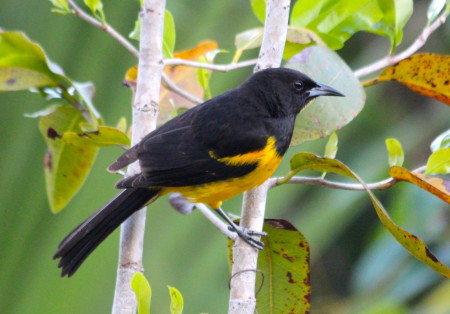
I can’t remember the last time I was so thrilled to be awake at 4:30 in the morning. There I was – meeting our team and boarding a plane to Nassau as part of a research team studying the Bahama Oriole (Icterus northropi)– considered to be one of the most endangered songbirds in the Caribbean. One thing kept running through my mind: if at the very start of college someone had asked me what sort of opportunities I thought I’d get as an undergraduate, I couldn’t have dreamed this would be one of them. What awaited me in the Bahamas were two incredible weeks filled with intense fieldwork, scientific discovery, a fair share of car troubles, and as much exploring as we could possibly squeeze into our spare time.
Here’s a quick summary of what our team was doing and how I ended up in the middle of it all. In 2015, Dr. Kevin Omland, my professor at the University of Maryland, Baltimore County (UMBC), began the Bahama Oriole Project in collaboration with Bahamas National Trust. At that time, the latest research on the species had come out in 2011 and indicated a declining population of less than 300 individuals. However, conservation efforts were hindered in large part due to the lack of sufficient information about this species. The Bahama Oriole Project was launched with the goal of reversing the bird’s decline through research, conservation and education. I was fortunate enough to join the team, and funded in part by a grant from The Explorers Club Youth Activity Fund, take part in this field research trip alongside Dr. Omland and three other UMBC undergrads. This was the Project’s first official research trip and my first experience with international fieldwork.
On that oh-so-early early morning in May 2016, we flew from Baltimore to Nassau, then chartered a six-seater plane that took us to the only place in the world where the Bahama Oriole is found today: Andros. It’s the largest and least developed island in the Bahamas with a population of nearly 8,000 people. Andros is a sort of island complex made up of three major landmasses (North Andros, Mangrove Cay, and South Andros) and smaller cays that are separated by channels and creeks. For now, our research is primarily confined to our study site in the northern portion of North Andros. Once we landed, we headed to where we’d be staying (Nicholls Town). After unpacking, the exploration finally began.
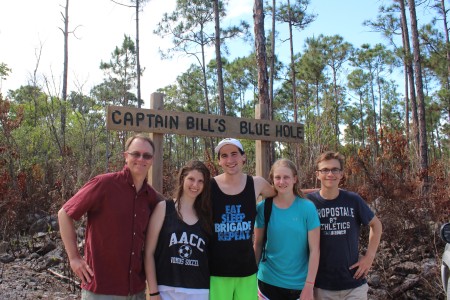
When I take a step back for a second, the thought of taking four undergrads that don’t know each other to another country for two weeks of field research might seem a little crazy. But to what I’m sure was Dr. Omland’s delight – our team ran like a well-oiled machine from day one. While we did spend some of our time all working together, each undergrad had a particular focus throughout the trip. Jennifer Christhilf was our team’s Magellan; she traversed our study area recording GPS points and habitat measurements to construct habitat maps of the island. Alex Scarselletta and Michael Rowley concentrated on the population surveys. Roni Rolle, a local college student from the Bahamas Agriculture & Marine Science Institute (BAMSI), also joined our team. His expertise on all-things-local was a tremendous contribution to our work. Before our UMBC team even reached Andros, he worked in the field to collect preliminary data by locating orioles and nests. A few days before we arrived, he found something particularly compelling while working in a pine forest– an apparent active oriole nest in a pine tree (Pinus caribaea).
Out of context this finding may seem insignificant, but here’s the thing: all previous research indicated that the orioles nest primarily in nonnative coconut palms (Cocos nucifera) in or near residential and agricultural (anthropogenic) land– but never in pine forests. Not only that, the research suggested that the oriole is dependent on the anthropogenic habitat for nesting. These findings formed the basis of what we thought we knew about the Bahama Oriole and had several important implications. Notably, these assumptions played a defining role in population estimates; and also in determining what conservation efforts would be most effective to protect the species. Any real discovery of pine forest nesting would then have the potential to shake up the basic understanding of Bahama Oriole breeding ecology and affect research and conservation efforts.
On our first day of fieldwork, Roni took us all to the nest site and to our surprise, there it was: an active nest in the pine forest, and actually in a Caribbean pine. This turned out to be a nest of two adult Bahama Orioles that successfully fledged young several weeks later. One of our questions now became whether this nest was an outlier or whether we were on the cusp of an important discovery.
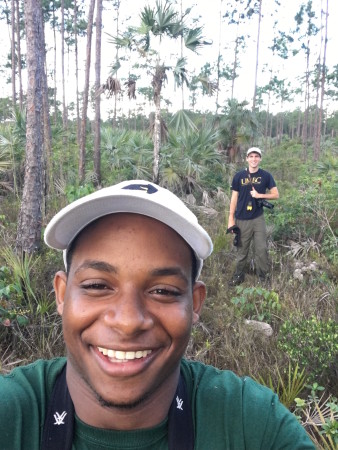
Roni and I ended up working together for most of the trip. We primarily focused on finding orioles and locating nests, especially in the pine forest. All the while- the pine nest was in the back of our minds. What if there were more nests in pine trees? Even more likely, we speculated: what if they’re also nesting in the native palms within the pine forest understory?
During their randomized point counts, Michael, Alex and Dr. Omland heard Bahama Oriole vocalizations at several other locations in and near pine forests. Using these locations as leads, Roni and I scouted them out to see what we would find. One morning in the later portion of the trip we followed one of these leads, which took us down to the southern part of our study site (near the nest Roni found before we arrived). The area is an expansive pine forest with little human development nearby. We parked our car just as the sun was rising and set out hiking. To our surprise, we quickly found a pair of orioles. After over an hour of vigilant following, the pair eventually flew too far away to track. We headed back to the car, glad to have found the pair but sorry that we had lost track of them. As we packed our things up, Roni and I immediately froze at the same instant. We had both just heard it – the distinctive song of the oriole. The bird was perched in a nearby understory palm, but it quickly flew further into the forest.
Now, it is worth taking a moment to describe the typical understory of pine forests on Andros. First of all, the ground is sharp, jagged limestone that makes simply walking an ankle-twisting hazard. Worst of all though, the understory is often dominated by poisonwood (Metopium toxiferum), a type of tree in the same family as poison ivy. Poisonwood can cause some wicked blisters if you contact any part of the plant.
Once we saw the bird fly deeper into the forest, I think we both had the same internal questions: how badly do we really want to follow this bird/potentially find a nest, and would be it be worth the potential poisonwood rashes?? Throwing caution to the wind, we sprinted after the bird and into the forest in close pursuit. All in the name of science! We did our best to keep it in our sights and listened carefully for any vocalizations.
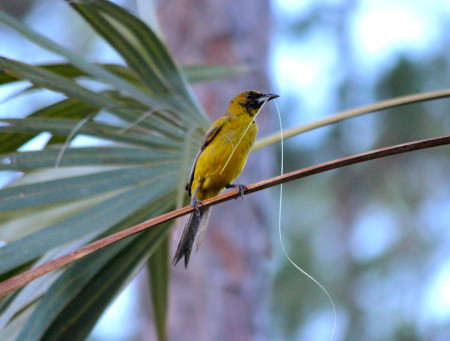
In retrospect, I can say that the poisonwood rashes I ended up getting several days later were definitely worth it, because after nearly 20 minutes– we found the nest! On the underside of a frond, the oriole had built its nest in an understory thatch palm (Leucothrinax morrissii). After tracking the bird to the nest, another individual soon appeared. We stuck around for a while to gather measurements, observe more behavior, and– of course– take a nice selfie with the nest tree. I was particularly surprised by the pair’s nonchalance with our presence. Before we knew it, the female was hard at work building her nest once again. She hopped from frond to frond on a nearby palm and skillfully ripped off fibers. Then she flew back to the nest tree and artfully wove the pieces together. How cool was this?! Not only did we find the nest in an unexpected place, but we also got front row seats to watch the nest being built!
In the following days, our team found several more pairs with territories in the pine forest, and we even found a second nest in an understory thatch palm about one mile from the first understory palm nest. As the trip drew to a close, our team of undergraduate researchers was quite proud of our work. We all made significant advances on our respective research projects, plus spent some free time exploring, swimming in blue holes, and snorkeling in the ocean.
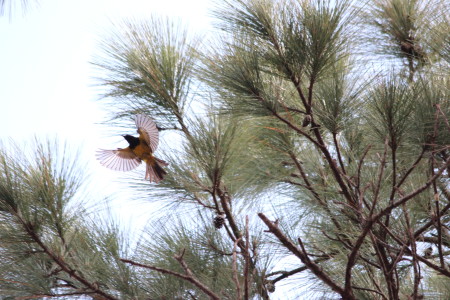
Our ability to protect any given species is contingent on having a relevant and accurate understanding of the species. These findings revealed, for the first time and contrary to previous assumptions, that pine forests on Andros are in fact a viable breeding habitat for Bahama Orioles. This new information elevates the significance of the pine forest habitat in terms of oriole breeding ecology. These findings also suggest a need to revisit prior population estimates, since their accuracy depended on the supposition that orioles don’t breed in the pine forests. The team is looking for funding to build on our initial findings and conduct comprehensive point counts across the entire Andros complex.
The discoveries and knowledge gained on this trip (through documentation of pine forest nesting, population sampling, habitat mapping) together allow the Bahama Oriole Project Team to refocus future research by refining the questions we ask. For example, we now know that the orioles nest in the pine forest; this provides unprecedented and critical justification to investigate the potential predators that are present in and/or unique to this habitat. Feral cats, for example, are infamous for their ability to prey on birds. We know they are present in residential areas throughout Andros, but what about deep within the pine forests? If so, could they (or other predators) threaten Bahama Oriole fledglings? On a second trip to Andros this past January, I used motion-activated trail cameras to see what exactly was lingering in the pine forests…but that’s an exciting story for another time.
Stay tuned for Part 2: Finding Bahama Oriole Nests in the Pine Forest—Reflections from a Young Scientist
